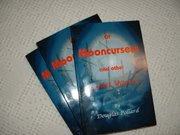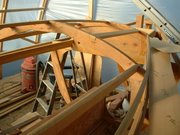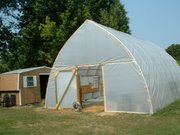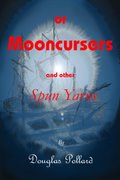Of Mooncursers and other Spun yarns

Click the link below and go to my book site
Of Mooncursers and other Spun Yarns
Thursday, January 18, 2007
Tuesday, January 16, 2007
Sailboats fair and Fine#16: read oldest posts first
We had stopped at the dock and took on fuel to the tune of three gallons. A couple bags of ice and we were all set for a few days. While there I put the mast, centerboard and rudder to the Dyer Dingy. A wonderful little sailing dingy though not strong enough to be left tied to a dingy dock with twenty other boats banging into it. We had learned a long time ago to pull her ashore. She if not beat up by other boats was likely as not to windup under a dock. Being so lightly built an incoming tide and a few boat wakes would wreck her surely. The other thing we did was to leave her on a long painter and that way all the other dingies would be pulled in front of her on short lines. Those boats kept ours from getting under the dock and no one ran into her as she was out of the way. All the years we owned her about fifteen in all nobody stole the rigging. Pretty amazing I think, considering all the places we took her.
The tide was now to our liking as it was about slack and would soon becoming in.
Parrot creek where we were going is shallow so we didn't want to get their on a complete high or low tide. Either one could be a problem and if we had an unusual high one which was likely after all the easterly wind we cold wind up setting on top a bar for a month waiting for another high tide. If we should get there at high tide we'd go in with our depth finder down. About four foot of center board sticking out Woftrap's bottom.
Our batteries were getting low, evidence a sluggishness in starting the engine. ( would have to be more careful with that). With that in mind we headed out motoring. Here is an unhappy thought. The screw we wound up with on Woftrap was not exactly right. The engine was only coming up to twenty eight hundred RPM's she was designed to run at thirty six hundred tops. At that lower speed we weren't getting full horse power out of her but worse than that she was blowing some black smoke. We'd come to regret that.
The wind had backed around to a light breeze from the South West. We hoisted the foresail sheeted her in and was soon motor sailing at six knots.
In about an hour we were off Parrot's creek and ready to head in. Wanting to be pretty coming in I hoisted sail and slowed the engine, leaving it run slow.
Every where we went with her we caused a stir and for me that's no small thing. The folks in this little shallow creek were not used to having sailboats of any size come in. They were very appreciative and came down to the boat landing to look at Wolftrap. Oyster shucker's at the oyster house must have been on break they stood on the dock point at us and talking. We were anchored in about four feet of water. We let the engine run another hour. The propeller always spun slowly while in in neutral so Wolftrap needed to be anchored between two anchors if the engine was to be run for charging batteries. She would run to the ends of the to anchor rodes and set there.
“Oh Thank you so much for coming into my creek and I hoped you will keep her here from now on” a lady who lived just across the creek said. Georgene, Replied well thank you,” but we will be leaving in a few days. Oh I'm so sorry but I'll tell you what, I'll will have a dinner party on the patio and you will be my backdrop. She wrote down everything Georgene told her about Wolftrap so that she could tell her guests.
Our Son, daughter in law and grandchildren lived a couple miles down the road so we set off walking. The lady didn't offer us a ride and beeped the horn and waved as she passed us on the road
We had a couple nice days with the kids and took a little time one day to explore the creek in the dink. We followed a small meandering gut that went through marshlands and small hills on all sides. Cranes, red wing black birds, geese, and ducks seemed to ignore us as we made our way. A little way off there was the crashing through the woods of a hound who let us know where he was by baying as he went. Figuring we had interrupted the daily lives of enough wild life we headed back to the boat. Each of us took an oar and practiced the art of tandem stroking of the water. While setting backwards. Georgene had one arm in a sling so only had one hand to pull an oar. I rowed with one hand to. With a light breeze behind us it didn't take too long to get to the boat.
We bought oysters at the shucking house and hung around watching the women shucking oysters a little while. They carried on a steady banter about one thing or another. A fair amount of it being about this fellow or that with a lot of somewhat dirty sounding giggling and laughing. Sure made a fella glad he'd never been out with any of them because there is no telling what they might say, for the amusement of all.
Our daughter Elaine, being a tidewater gal fried us all oysters for dinner. they were golden brow, moist and just right. I'll be John Brown if they weren't good.
We would be leaving tomorrow so the kids would see us off in the morning. We spent the night with the kids and let Wolftrap fend for herself. It felt pretty good to sleep in a real bed.
Posted by
Doug
at
1/16/2007 03:17:00 PM
0
comments
![]()
Labels: Jahn Brown, Oyster shucking house, Oysters, Parrot's Creek, rowing tandom
Sailboats Fair and fine#15; READ OLDEST POSTS FIRST
We rolled out about eight in the morning. I was pretty chilly so I started a fire in the little cabin heater and crawled back under the covers and backed up to Georgene who pushed me away and fussed at me for getting in bed and freezing her. In a little bit we could feel warm air coming into the forward cabin. In a moment Georgene got up and put the coffee on the cabin heater. There's not a lot of tide in Urbana Creek so we were laying into the wind. The breeze kind of medium was somewhat variable in direction, it was swinging from North east to east and back.
An elderly Deltaville schooner Captain named Edmond Ruark away back when I was about thirty couple years ago told me that, “If the wind blows out of the North East and it doesn't rain it will never rain again”
"Georgene," I said.
Absently she said, “Yes”
“Georgene,” I said again,
“What, Douglas, “ and I could here the pages of her book flipping shut.
“We're gonna get wet today, It's going to rain.”
I heard the hatch open and then close and she said, “No, it's not cloudy at all.”
We dingied ashore and walked to the Urbana drug store and its double horse shoe lunch counter was full of people. “Coffee y'all?” a middle aged lady inquired of us.
“Yes mam,” I answered.
She turned in the swivel chair and said to the waitress, “Laura these folks need a hot cup of coffee.”
"Hi y'all, want'em fer here," she said with a big toothy smile.
“Two please,” I answered.
A fella got up and offered Georgene a seat and she tried to talk him into setting back down. He'd have none of it so she took his offer, thanking him. Didn't look like anyone was going to offer me one so him and stood drinking coffee.
A fellow walked through the door and said. “Wee, it's raining already. And all heads swiveled to look out the big front window as though they never had seen rain before. One lady said sure is, and someone else said yep sure is.
George turned to me and said, “How did you know it was gonna rain.”
“Captain Ruark, told me,” I said grinning.
“You know, Captain Ruark? By the way I'm Dan that's ma little boy Danny right there”. Danny half stood and grabbed my hand in his and eagerly shook me all over. He was about six four and three hundred pounds and playful as a puppy.
I told them all, Ed's saying. They all smiled knowing smiles. One said , ”He's one that would know for sure.”
“Yeah Capt. Ed knows about all there is come sailing a schooner. I sailed with him when I was a youngun about like him, cept maybe a hundred pound sack of potatoes lighter. That was the, Schooner Columbia F.C, we was on and she was the fastest schooner around in them days.” Dan's head was moving up and down as though he was agreeing with himself.
“Capt. Ruark, was about the best they was when it comes to dead reckoning. Believe me I know cause we had a lot of Schooner captains over to, Christfield, where I come from."
"The Schooner was tied up at Pratt and light street aside the Steam boat, Smoky Joe ferry“Now it was one foggy night when we left out of Baltimore. It was in the middle of the night in the middle of January an in the middle of the channel.” Dan laughed at his own little joke and we all laughed with him. By now we were all leaning forward listening. It was pretty obvious that Dan is the local teller of stories.
“There was a North Easter blowing and a little snow was coming down through the fog. We sailed right down the, Pottapsico River, and out in the bay past, Seven Foot. Knoll The fog was so thick you couldn't see the end of the bow sprite.
"Why, dead reckoning of course, Replied the Captain."
"They weren't no bay bridge there at Annapolis in them days Ya know. Any ways we sailed all day and you couldn't see noth'en. There was ice on the sails and rigging.' Now y'all can believe me them old fog horns was sounding, you couldn't tell where they was coming from in all that fog. We sure wasn't in the channel cause the whole way we never did see any buoys. Feeling a little concern, I again said if we don't soon see a buoy how the heck we gonna know where we are Captain. Captain ED again said, Why dead reckoning of course. We was all straining our eyes looking to be sure we didn't run over noth'en. The fog was so thick the sun didn't even shine through and I swear if you stood up forward you could hear the bow cutting through the fog.” A snicker went around the counter and little Danny slapped his ham hock of a hand on his leg and roared, we all laughed at him.
“After another couple of pretty scary hours Capt ED said Dan lets get the sail off'er and be quick. We'll tie up to the stake in the middle of the creek till morning' Captain Ruark barked forward at us. The sails was doused and I went up on the bow and stood . Captain Ed, yelled tie'er up. I said Captain they ain't noth'en I don't see no stake."
"Put your hand out there and I did and sure enough I grabbed hold of that stake and took a line aroun'er. I said in surprise Captain How the heck did you know it was there and he said, Why dead reckoning of course."
"Dan reared back on his heels shook his head back and forth and said now they ain't nobody knows a better Captain Ruark tale than that." Everybody busted out laughing and all stood up and clapped.
"Danny get up from there Dan said quickly. Folks I was gonna tell a story on my little women but she's coming across the street now an I don't want her to catch me talking about her, she will beat the tar out a me."
A little tiny women stuck her head in the door and yelled "High everybody I'll see y'all at the oyster festival gotta git home, Come on Dan, Danny lets git."
Posted by
Doug
at
1/16/2007 10:00:00 AM
0
comments
![]()
Labels: Annapolis, Baltimore, Columbia F.C., dead reconning, Urbana
Sunday, January 14, 2007
Sailboats fair and fine#14: Read oldest posts first
Sometime in the morning I awoke to the slap, slap sound of waves hitting the hull. I raised on one elbow, pulled the curtain aside on the elongated port light to see what was going on. The sun was not up yet but there was the morning greyness all around, with just the faintest touch of gold in the eastern sky. Then another work boat came by. It was a local water man named Talmage. I started to get up but eased back instead to my bunk and was off to dream land in a hurry.
The next thing I knew it was light inside the boat and I could hear and smell coffee brewing and bacon frying. Georgene was setting on the stool at the stove reading a book. I lay there a few minutes watching the intentness with which she read. I remember thinking one time that every young man that wants to mess around on boats first needs a young lady. Not just any good looking gal but one that likes to read. Don't matter whether she likes boats or not. She needs to be a good sport and like to read. During those moments when you watch a calm sea, a seagull diving or swooping along a wave top she'll be reading You may even be listening to a dog bark on a somewhat distant shore, she'll be reading. If you take the girl along that doesn't read she'll be talking. Oh yes give me the girl that reads every time and all the better if she likes to read to you. Nothing makes a man feel more like a king then setting in the cockpit of his boat sipping coffee or a sundowner while being read to in the softness of a feminine voice. So sweet!
I made my morning trip to the head for a quick pee. That's the trouble with an Anchorage where you can't pee off the stern because there is houses everywhere. Shaking the thing over the transom is every bit as satisfying as cutting down a tree to my mind.
I took my coffee out to the cockpit and studied my world. In a few minutes my eggs and bacon was handed to me with buttered toast made over the stove.
In about an hour I started up the engine went forward with the engine idling in forward. I took in the excess anchor line as we motored over top of it. I made the anchor line around a cleat and said Georgene she looked up from her book and I waved my hand in a circle with three fingers sticking up and pointed the direction I wanted to go in. The boat came over the anchor and pulled it out and I held up my hand and pointed out and a round to head out as I then started pulling the anchor in. I grabbed up the boat hook and laid the anchor over the hook under the Bow sprite. She ran the boat out of the creek and headed out to the bay. I went below and got us another cup of coffee and we were on our way to the old town of Urbana on the Rappahanock River. We motored along slowly at about half throttle. We dropped over a couple of spoons on our fishing rods and trolled them along. It was a beautiful morning the sun was high enough to not be right in our eyes. As we rounded stingray point on the wrong side,a thing we could do with our shallow draft we watched a Menhaden ship with its accompaniment of open boats take in a what must have been five tons of fish. The old ship was one of the last world war one Submarine chasers still left in the fleet. She was really handsome in her own way . Long and slender and built for speed. She was painted Grey that to me seemed so very fitting. We motored along slow and finally in early after noon we went under the Rapahanock River Bridge. Just about that time we snagged a fish .and I reeled him in. He was a late blue fish. I took in the other rod as one fish was all we need for tonight's supper. I would guess he weighed seven pounds. I put him live in the cooler.
A slight breeze cold and moist came in from the east so we hoisted sail and was soon sailing along about three knots. There was a wall of fog rolling in behind us that looked to be about a thousand feet high. As we sailed west we could see that it was slowly catching up. We put on heavier cloths and hats. It wasn't long before I went below and put on long underwear. We were just out of summer and I guess our blood was thin. The dampness didn't help any. In a few minutes Georgene came out with long underwear showing around her collar and foul weather gear on and she was carrying mine. We changed into boots and gloves next. The temperature was in the mid to upper forties and that's cold when you still wearing your summer blood. We fired up the engine again in a vein attempt to stay in front of the fog. Before we got to the creek it caught us. I had taken a bearing on the harbor mouth and we headed for it. We took down the sails and motored very slowly using the Loran and the boats tied in their slips along the west shore. They are easy to follow as the white hulls make them more visible than the brush and trees on the east bank.
After a bit I figured we were in the middle of the creek right off ED Hurley's marina. A spot that held a little romance for me. This was the spot where I had back in the 1950's moored my Hershoff 18 for about five years.
We dropped the hook and started making coffee. In a few minutes somebody said hey “Wolftrap, Wolftrap I wouldn't anchor there.” Georgene, half shouted, “Look come here look.” I had no idea what she saw but when I looked aft there was the gas doc ten feet behind us. In a very short time the waterman would be coming in to unload at the dock With the fog they were most likely coming in the creek now. It wasn't a problem because they wouldn't likely run over us but I sure would be embarrassed to have them catch me anchoring right in front of the dock. We got a way and re anchored just as five boats came to the doc. And four others circled around. One of them came close by and yelled, "Hey Doug don't ya know no better'en to anchor on top the dock."
"How'ed you know," I yelled back.
"Ed called out on the radio and told us to be careful cause some yachty was anchored almost right on the dock."
When the time would come to go back to Deltaville I knew I was going to catch it, because the story would be something like I anchored on the dock and couldn't start my engine and half the fleet had to circle around for an hour in the fog.
That blue fish was good. Didn't have any lemon so we poured a little jigger of white wine on him when he was frying. Holy cow! Was that a meal?
Posted by
Doug
at
1/14/2007 03:31:00 PM
0
comments
![]()
Labels: AnchorageMenhaden, distant shore, hull, smell of coffee brewing, Urbanna




